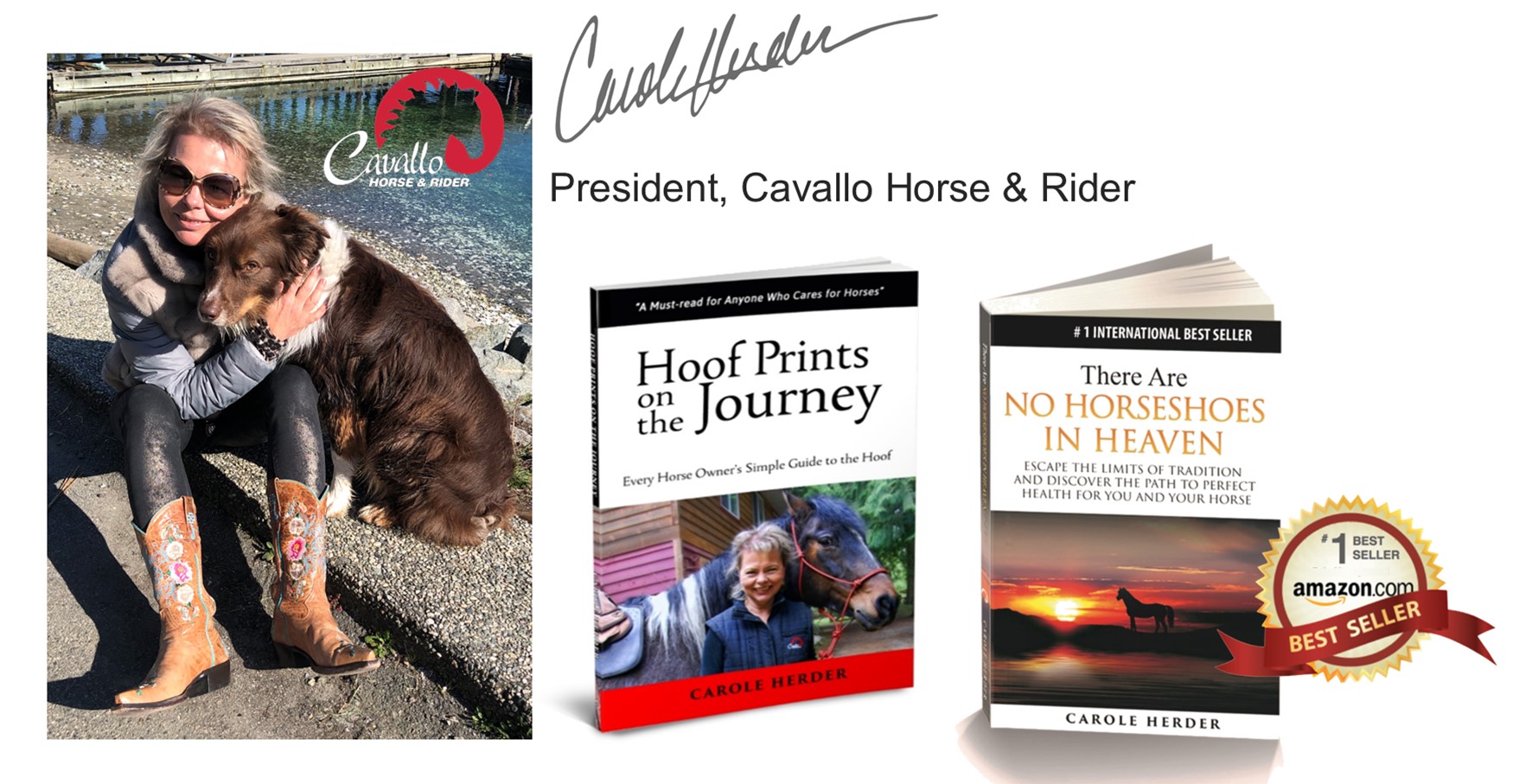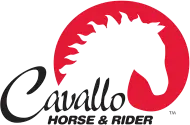Laminitis Plan Series: Part 1
-
February 9, 2024
-
8:08 pm
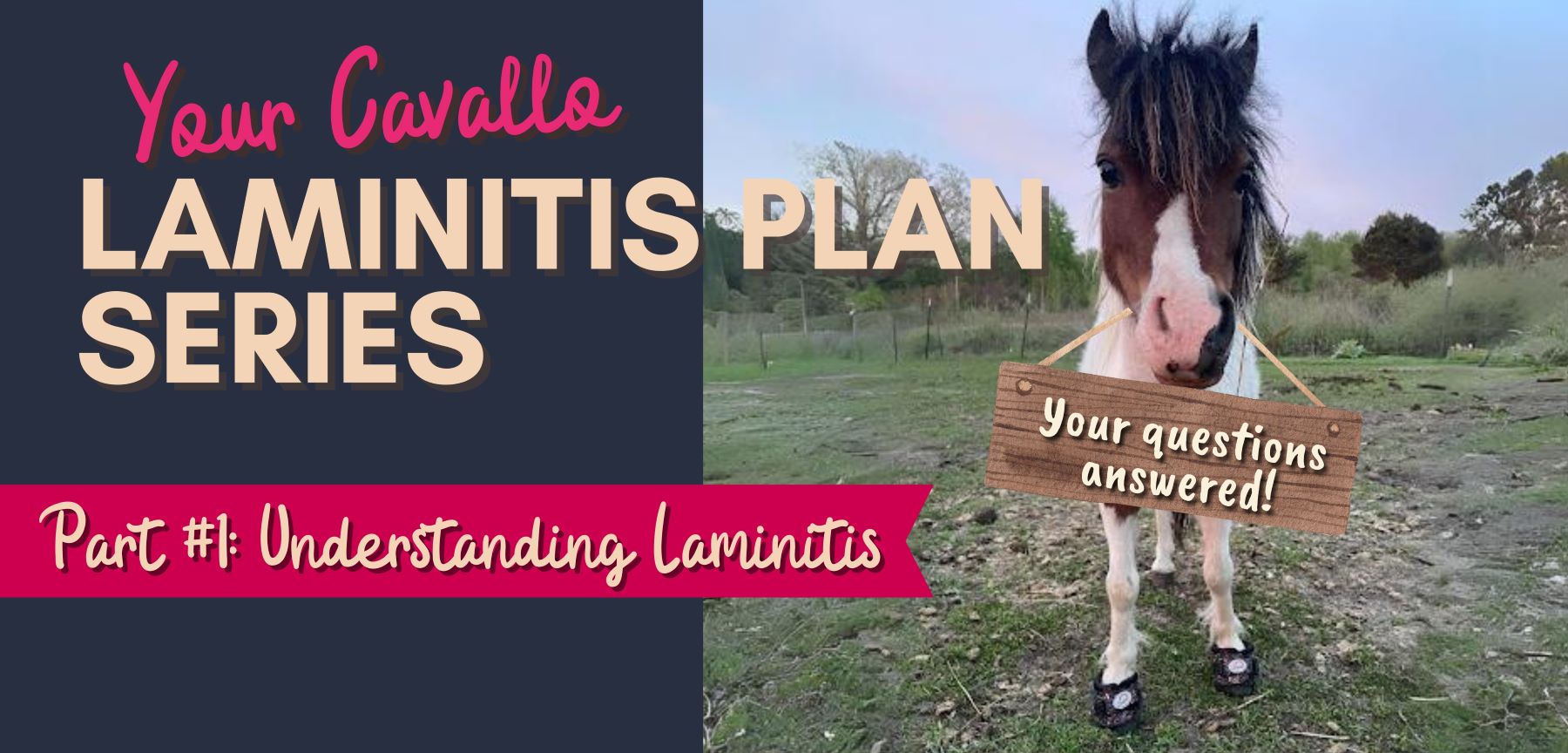
Welcome to Your Ultimate Laminitis Guide, Part 1: Understanding Laminitis
It’s a horse owner’s nightmare. To see your horse walking stiffly, shifting his weight off his front hooves, or not wanting to move at all can mean hoof damage and pain. Here, we’ll walk you through what to do if you suspect Laminitis. How to simply alter your daily horse care to promote health and healing, and how to navigate your horse’s recovery.
I am a horse owner, and my team and I have worked with many horse owners as they support their horses through Laminitic episodes. We’ve compiled these horse management tips to help your horse feel his best as soon as possible. And of course, before beginning any hoof care regime, make sure to always consult your veterinarian.
We are going to walk through 3 topics about laminitis, based on our experience:
Topic #1: Understanding Laminitis
Topic # 2: Managing Laminitis with Cavallo Boots
Topic #3: Hope and Recovery
This page, Part 1: Understanding Laminitis, covers the most common questions we hear about booting with Cavallos to help manage pain and protect the hoof while healing from Laminitis. We hope these shared experiences and case studies will help your horse–and we wish you the best of luck during your horse’s healing time.
Answers to the most common Laminitis questions we hear at Cavallo:
"What actually happens to hooves during Laminitis?"
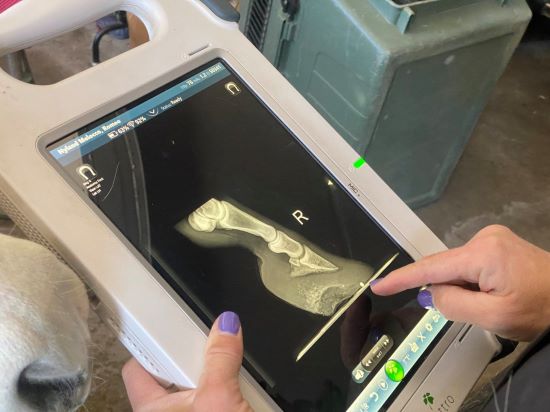
Laminitis, simply put, is like a breakdown of interlacing fingers, except these “fingers” are made of tissue (called lamellae) that attach the bone to the hoof wall. Compare it to a Velcro attachment, but instead of being made of synthetic material, it is live tissue. You can imagine this living matter, ripping apart, can be VERY painful. When the strength and quality of lamellae fail, these tissues are compromised; the bone may tear away from the hoof wall. The toe of the coffin bone could even plunge through the sole of the hoof, delivering merciless agony.
"How will my horse tell me he's suffering from Laminitis?"
There are various signs indicating symptoms of Laminitis, such as shifting weight from one foot to another, appearing sore, frequently lying down, protuberances in the hoof, irregular appearance, reluctance to move, unwillingness, rocking back and forth, sweating, increased heart rate, and even staggering. If you suspect a problem, consult your veterinarian immediately.
"How does what my horse eats affect his hooves?"
Everything your horse ingests influences his microbiome (the microorganisms in his body). The gut guards the immune system as it’s constantly exposed to new microbes, bugs, germs, and bacteria from food and water. The process begins in the stomach and small intestine with dizzying amounts of bacteria colonizing the upper intestinal tract. This commotion of sugars and starch produces lactate and volatile fatty acids, which are then absorbed by the horse and used for energy or to produce fats or glucose in the liver. This fermentation process reduces the blood sugars and amounts of enzymes required to digest.
The cycle results in more microorganisms being released into the intestinal fluid to help cultivate good bacteria. The same activities continue with even more bacteria in the colon, which then provide some resistance to viruses or bacteria that may be harmful. Your horse is a hindgut fermenter, which is a good thing because it means the flora of the hindgut can process, for a second time, the massive amounts of fiber he ingests. But this leaves horses vulnerable to failure to digest large amounts of sugars. Gut bacteria are essentially and inextricably connected to metabolism, immune function, vitamin and mineral absorption, central nervous system function, and mental health. The microbiome is at the forefront of progressive studies regarding the complete health of our horses and ourselves.
Notice Changes in your Horse During Winter?
What is “Winter Laminitis”? The physiological repercussions of cold temperatures coupled with restricted physical activity may lead to excessive constriction of blood vessels, resulting in compromised circulation essential for nourishing cellular structures within the hoof. Vasoconstriction, an inherent protective mechanism to prevent excessive heat loss, can inadvertently impede the dissemination of vital oxygen and nutrients crucial for averting a Laminitic episode. In the event of suspicion of this cold-induced phenomenon now denoted as Winter Laminitis, it is recommended to promote horse movement by providing the comfort of Cavallos and wrapping the lower limbs to maintain warmth. Consultation with a veterinarian regarding circulatory-enhancing medications to vasodilate the blood and reinstate the proper distribution of oxygen and nutrients necessary for the well-being of hoof tissue is also advised.
"Is it true that "moving is healing" for a Laminitic horse?"
The mental well-being of your equine is as important as his physical well-being. When pain is alleviated for a horse with Laminitis or any other painful hoof issue, your horse is happier and able to move more. Movement is your horse’s modus operandi. Moving stimulates blood flow, and the nourishing blood can work to the problem areas to facilitate faster, more effective healing. It’s also helpful to make sure your horse can see or be near his herd mates so he can be calm as he heals.
"How has Laminitis been treated traditionally?"
We generally treat Laminitis as a hoof problem. Some suggest hoof supplements, nerve blocks, bar shoes, frog support, and corrective shoeing, such as lowering the heel and applying wedge pads. It seems counter-intuitive to lower and raise the heel, but these are some conventional treatments used. Some wedge the hoof in a “reverse wedge” to lever the coffin bone up at the front and back into the wall. Any wedging should be considered temporary, in compliance with corresponding angle percentages shown on radiographs, and monitored regularly.
Some recommend exercise to prevent obesity; others advocate box stall rest and confinement. Feed restriction is also a prescription. There are many considerations in treatment, but horses get uncomfortable when food is unavailable and stress levels elevate, so restricting feed should be a careful consideration.
Timing is essential in treatment, as is an understanding of the horse’s nature. Misperceived cures and treatments can increase levels of anxiety, thereby aggravating the distressing state of affairs further. Large doses of vitamin C, turmeric supplements, and even whole milk cream added to the feed have been touted as cures. There are countless opinions. It can be simple or very complex, which is the way of many things, including Laminitis. Seek help, seek knowledge, and develop an understanding of a horse’s nature. Make prevention your greatest tool.
"What can I do to help my horse feel better right away?"
The instant you have a diagnosis of Laminitis, you must act to make your horse more comfortable. Provide a soft bed for him to lie in, and if he prefers to remain standing, place his hoofs in Cavallo Boots with padded insoles. Cavallo offers a range of pads that can be used depending on the severity. You could even tape foam to his feet while waiting for your boots to arrive. Ice therapy treatment performed promptly will improve the situation dramatically. Unfortunately, this window of opportunity is only about 48 hours, so you must have a keen eye to identify the situation and move quickly.
Cavallo Trek Hoof Boots Unveiled by Western Kentucky University Research!
Let’s step into the groundbreaking study conducted by Dr. Jennifer Gill and Gabriella Lynn from the Western Kentucky University Equine Science Department. They concluded the first-ever independent university comparison between hoof boots and traditional metal shoes, with their top pick being the remarkable Cavallo Trek Hoof Boots.
The research delved into the surface area, force, and pressure exerted on horse hooves navigating the unforgiving terrain of asphalt. Employing cutting-edge FujiFilm imaging, the scientists gauged the pressure experienced by the hooves, revealing dynamic insights through vibrant color mapping.
According to Dr. Gill, “The Cavallo Hoof Boots proved to be a game-changer, safeguarding the entire hoof and surpassing other forms of protection like traditional horseshoes. The thicker tread of the Cavallo Trek Hoof Boots provided superior ground contact compared to metal horseshoes.”
The results were unequivocal in favor of Cavallo Trek Hoof Boots, as Dr. Gill explains, “The pressure recorded with Cavallo was significantly lower than other treatments, precisely as we anticipated. The increased surface area in contact with the ground, thanks to the substantial tread, offers horses better traction and enhanced ability to handle forces and pressure on challenging terrains.” Continue reading HERE.
Stay tuned for our Cavallo Laminitis Series Part 2: ! We’ll dive deeper into how to offer your horse relief during their recovery, using Cavallo Hoof Boots as a crucial tool to give your horse the most comfort possible.
Bonus Hoof Care Resources
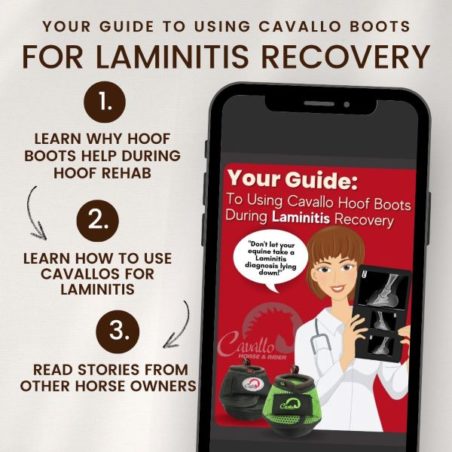
Download your Free Laminitis Guide:
Be sure to keep my quick and easy Laminitis Guide handy! It has all the pointers you need to help you get started using boots to help your horse.
PLUS, it contains a selection of uplifting stories from Cavallo users who have successfully rehabbed their horse with the assistance of their Cavallo Boots:

Download your Free Barefoot Trim Manual & Video:
From age 10, Lynn Seeley had been shoeing horses. Lynn understands how the hoof affects the entire horse and went on to improve their well-being through the removal of metal shoes and trimming barefoot horses to health and soundness.
Now, with over 60 years of practice, Lynn shares his gentle trimming method through this illustrated manual and accompanying video (hosted by me!) This valuable manual should be in every horse owner’s library, either as a reference for yourself or as guidance for your Trimmer.
Get your FREE Barefoot Trim Manual:
Cavallo Cares
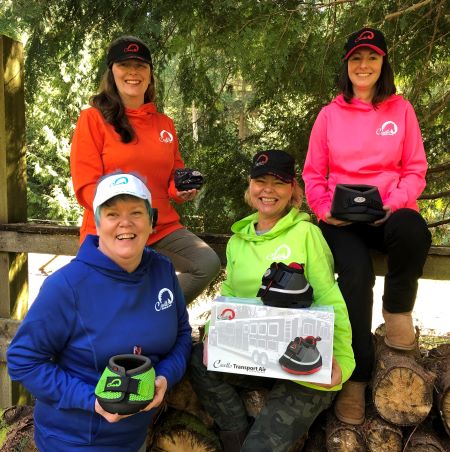
At Cavallo, one of the most common reasons people reach out to us is for help with Laminitis. I’m proud to say that Cavallo Boots have a long, proven track record of keeping horses on their feet while healing from an attack. The relief experienced by a horse can be seen instantly. We receive emails daily thanking us for how the boots helped their horses. To say that my job makes me happy is an understatement. Every single letter that comes our way makes me smile!
Find more info about using your Cavallo Hoof Boots to help your horse heal from Laminitis HERE!
Check out this Q&A article discussing how to use Cavallo Hoof Boots for horses’ hoof rehab and why veterinarians recommend them HERE:
The Cavallo website contains research, testimonials, and FAQs to help guide you as you transition to barefoot and prepare to ride in any sport. Visit www.cavallo-inc.com for more help, or join the discussion on Facebook.
Sign up for Cavallo’s free newsletter and special community discounts HERE!
(Hint: For a limited time, get a 15% off coupon code as soon as you sign up for your newsletter!)
Wanna talk? Call us toll-free from the USA or Canada: 1(877)818-0037.
Carole Herder is the author of the number-one International Bestseller books There Are No Horseshoes in Heaven and Hoof Prints on the Journey. Herder has been involved in horse health since 1993. Her company, Cavallo Horse & Rider Inc., develops, manufactures, and distributes horse products in 26 countries worldwide. Herder designed and developed Cavallo Hoof Boots and Total Comfort System Saddle Pads. Providing comfort for horses is her passion. She presents educational training worldwide on the benefits of keeping horses in their natural state. Herder is an honored award recipient of the Royal Bank of Canada Woman Entrepreneur of the Year, British Columbia’s Businesswoman of The Year, and North America Enterprising Woman of The Year and a certified Chopra University Yoga Instructor and Ayurvedic Teacher. She is a trailblazer and a proud member of the Women Presidents Organization, supporting female entrepreneurs in every industry.
Wishing you many happy trails,
